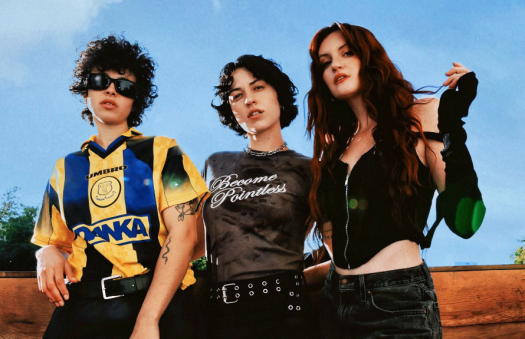The language of mainstream filmmaking has become so standardized that a movie like Under the Skin inevitably leaves many slack-jawed "movie lovers" no recourse but to dismiss it as pretentious nonsense. On the other end of the spectrum, critics and film wonks are more or less mandated to hail this confounding filmic equivalent of wingdings as a masterpiece. I think it probably is one.
Above all, Under the Skin is strange and unsettling. It feels a little bit evil. You wouldn't be surprised if it caused theatre projectors to overheat, or Blu-ray players to explode, like The Bunny Game has been said to do. It asks us to take a hard look at our own spectatorial relationship to Scarlett Johansson's body while simultaneously giving viewers the most explicit glimpses ever of it. Surely, it cements Johansson as not just a top-tier movie star but also one of the best actresses working today. When her career is celebrated in award show tributes decades from now, the images from this film might just be the most iconic. It's the type of work that requires repeat viewing; yet, even the many who've lauded it as a breakthrough achievement are unwilling to endure such an affecting and unpleasant experience a second time.
In the film, an alien in human form lures men off the streets of Glasgow (many of whom were non-actors caught on hidden camera). Their thick brogues render about 70% of what they say unintelligible to North American listeners, but this helps the audience perceive the men as somehow alien themselves, the way Johansson's character might see them.
Once sexually enthralled and tumescent, the men are brought to an oozing lair of black liquid, and sucked into some inexplicable doom vortex. A guy on a motorcycle monitors the alien's actions and cleans up after her. She eats a piece of cake, and finds she doesn't like it. She hangs out in a mall. There's no explanation, no motivation; no logical framework is provided in Jonathan Glazer's grand vision. He spent nearly a decade adapting Michael Faber's comparably accessible novel, a satirical work in which an alien named Isserley harvests physically fit men because their meat is a delicacy on her home planet. Glazer eschews all of that, leaving only two essential questions: What does it mean to look at someone like Scarlett Johansson? More importantly, what does it mean to be human?
The alien displays no empathy during the film's first half. In one acutely difficult scene, a dog, a mother, a father and finally a baby are all put in severe jeopardy, one after the other. As the desperation peaks, an impassive Scarlett bashes the family's would-be-rescuer with a rock, much as a person might step on a cockroach.
Later she/it encounters a man with the facial deformity neurofibromatosis. For some reason he's spared the fate of the others. This kicks off the second half, in which the alien becomes confused by humanity and something like a plot emerges. One man tries to care for her. Another tries to rape her, fails, and lights her on fire. Fin. If those seem like spoilers, note that the nature of this film is such that there's no way to spoil this experience by describing the bare essentials of its plot.
The trailer highlights L.A. Weekly's accolade that, "We may finally have an heir to Kubrick," which is high praise, indeed. The opening sequence does evoke 2001: A Space Odyssey in some minor way, and the Mica Levi score, eerie low lighting and stark compositions all achieve a near-Kubrick level of technical perfection. But what gives the comparison merit is that Jonathan Glazer has made a film completely unlike any that have come before it.
(Mongrel Media)Above all, Under the Skin is strange and unsettling. It feels a little bit evil. You wouldn't be surprised if it caused theatre projectors to overheat, or Blu-ray players to explode, like The Bunny Game has been said to do. It asks us to take a hard look at our own spectatorial relationship to Scarlett Johansson's body while simultaneously giving viewers the most explicit glimpses ever of it. Surely, it cements Johansson as not just a top-tier movie star but also one of the best actresses working today. When her career is celebrated in award show tributes decades from now, the images from this film might just be the most iconic. It's the type of work that requires repeat viewing; yet, even the many who've lauded it as a breakthrough achievement are unwilling to endure such an affecting and unpleasant experience a second time.
In the film, an alien in human form lures men off the streets of Glasgow (many of whom were non-actors caught on hidden camera). Their thick brogues render about 70% of what they say unintelligible to North American listeners, but this helps the audience perceive the men as somehow alien themselves, the way Johansson's character might see them.
Once sexually enthralled and tumescent, the men are brought to an oozing lair of black liquid, and sucked into some inexplicable doom vortex. A guy on a motorcycle monitors the alien's actions and cleans up after her. She eats a piece of cake, and finds she doesn't like it. She hangs out in a mall. There's no explanation, no motivation; no logical framework is provided in Jonathan Glazer's grand vision. He spent nearly a decade adapting Michael Faber's comparably accessible novel, a satirical work in which an alien named Isserley harvests physically fit men because their meat is a delicacy on her home planet. Glazer eschews all of that, leaving only two essential questions: What does it mean to look at someone like Scarlett Johansson? More importantly, what does it mean to be human?
The alien displays no empathy during the film's first half. In one acutely difficult scene, a dog, a mother, a father and finally a baby are all put in severe jeopardy, one after the other. As the desperation peaks, an impassive Scarlett bashes the family's would-be-rescuer with a rock, much as a person might step on a cockroach.
Later she/it encounters a man with the facial deformity neurofibromatosis. For some reason he's spared the fate of the others. This kicks off the second half, in which the alien becomes confused by humanity and something like a plot emerges. One man tries to care for her. Another tries to rape her, fails, and lights her on fire. Fin. If those seem like spoilers, note that the nature of this film is such that there's no way to spoil this experience by describing the bare essentials of its plot.
The trailer highlights L.A. Weekly's accolade that, "We may finally have an heir to Kubrick," which is high praise, indeed. The opening sequence does evoke 2001: A Space Odyssey in some minor way, and the Mica Levi score, eerie low lighting and stark compositions all achieve a near-Kubrick level of technical perfection. But what gives the comparison merit is that Jonathan Glazer has made a film completely unlike any that have come before it.




